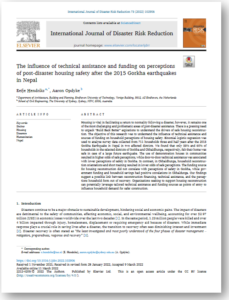The influence of technical assistance and funding on perceptions of post-disaster housing safety after the 2015 Gorkha earthquakes in Nepal
Abstract
Housing is vital in facilitating a return to normality following a disaster; however, it remains one of the most challenging and problematic areas of post-disaster assistance. There is a pressing need to unpack “Build Back Better” aspirations to understand the drivers of safe housing reconstruction. The objective of this research was to understand the influence of technical assistance and sources of funding on household perceptions of housing safety. Binomial logistic regression was used to analyse survey data collected from 711 households three and half years after the 2015 Gorkha Earthquake in Nepal in two affected districts. We found that only 55% and 60% of households in the selected districts of Gorkha and Okhaldhunga, respectively, felt their home was safe in case of a large future earthquake. The use of demonstration houses in communities resulted in higher odds of safe perceptions, while door-to-door technical assistance was associated with lower perceptions of safety in Gorkha. In contrast, in Okhaldhunga, household reconstruction orientations and short training resulted in lower odds of safe perceptions. The funding source for housing reconstruction did not correlate with perceptions of safety in Gorkha, while government funding and household savings had positive correlations in Okhaldunga. Our findings suggest a possible link between reconstruction financing, technical assistance, and the perceptions household form out of recovery. Organisations seeking to support housing reconstruction can potentially leverage tailored technical assistance and funding sources as points of entry to influence household demand for safer construction.
Potential Industry Impact
- The format of early recovery assistance has the potential to shape longer term community views of housing. With a community-centred approach, household priorities towards reconstruction can be placed in the hands of households who are best positioned to manage risk.
- Assistance mechanism shapes outcomes.
- Influencing perceptions, and thereby awareness of safer construction, is an important proposition to build more resilient recovery practices.

Authors:
Eefje Hendriks, Aaron Opdyke
Journal:
International Journal of Disaster Risk Reduction, Volume 73, 15 April 2022
Read:
https://doi.org/10.1016/j.ijdrr.2022.102906



Leave a Reply